Music Commissions Home | Music Commissions Brief History | Music Commissions Articles List | Composer's Guide to the Piano Accordion
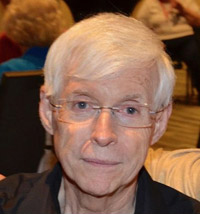
In the unlikely event that the legendary persuasive powers of Elsie M. Bennett as Chair of the AAA Composers Commissioning Committee were ever called into doubt, an examination of her now historic files of CCC contracts and correspondence should swiftly refute it. This is particularly true of those for 1960, for the AAA records reveal that between February and December of that year she achieved the remarkable feat of persuading seven major and very busy American composers to sign contracts to produce new works for the accordion, an instrument that still faced a long uphill struggle to gain wide acceptance in the serious contemporary music world, particularly in the United States. Their names, resulting works, and dates of agreement were Henry Cowell, Concerto Brevis, for accordion and orchestra, February 4; Otto Luening, Rondo, June 23; Paul Pisk, Salute to Juan, October 28; Alexander Tcherepnin, Partita, November 1; Henry Brant, Sky Forest, for jazz accordion quartet, November 7; Elie Siegmeister, Improvisation, Ballade, and Dance, November 10; and David Diamond, Night Music, for accordion and string quartet, December 8. The first three of these will be discussed in this installment.
Henry Cowell (1897-1965) was no stranger to the AAA since he had already composed a solo work, Iridescent Rondo, for the organization the previous year (the seventh AAA commission; discussed in the 2000 issue of the AAA Festival Journal). In addition, he managed to produce yet another solo accordion piece, Perpetual Rhythm (not for the AAA, and, interestingly, following the same scheme of modes that he described in the inside cover of Iridescent Rondo) that same year. Always a busy and prolific composer, Cowell had also completed his fourteenth symphony, Characters, for orchestra, and his thirteenth Hymn and Fuguing Tune, among other works, during the interim between the two AAA commissions.
As Paul Creston had done for his second AAA commission, Cowell decided to take on the ambitious project of a concerto for his. This would also be the second work for accordion and orchestra that the AAA commissioned up to this point. However, unlike Creston's concerto, which was highly virtuosic and followed the traditional classical design of three movements with a fast/ slow/fast tempo plan, Cowell's would be less technically demanding (though not to a great degree) and in five rather short movements, hence his chosen title, Concerto Brevis.
Another distinction to be drawn between the two works has not to do with their musical forms, but rather their premieres. While the Creston concerto received a critically acclaimed debut with Carmen Carrozza and conductor Arthur Fiedler and the Boston Pops Orchestra soon after its completion, the Concerto Brevis would unfortunately have to wait twenty-five years after its publication (by Pietro Deiro Music, in 1962) and long after its composer's death for its first performance with orchestra. This was finally accomplished on October 4, 1987, by Guy Klucevsek and the Temple University Orchestra, Luis Biava, conductor, and took place at the Port of History Museum, in Philadelphia, as part of the New Music America Festival. Brief, though favorable, mention was made of the concerto the next day in the Philadelphia Inquirer by critic Lesley Valdes, who wrote that Klucevsek "made a strong case for the piece, which was written as a way to review Cowell's stylistic manner. Cowell used the accordion's color rather than projection to make his music." I know of no performances before or since then with orchestra, though I suspect that it has probably been done with piano accompaniment, using the piano reduction of the orchestral part included in the Pietro Deiro publication of the score.

Left: Elsie Bennett and Henry Cowell, at Bennett home, August 16, 1959. |
Like Iridescent Rondo and Perpetual Rhythm, the Concerto Brevis is highly modal and rhythmically straightforward throughout and utilizes traditional forms of the Classical era, such as rondo form in the second, third. and fifth movements; A-B-A ternary form in the fourth movement; and contrapuntal through-composed treatment of a brief single melodic phrase for the first movement. The orchestration accompanying the accordion is within the bounds of long-standing tradition as well: two flutes, two oboes, one B-flat clarinet, two bassoons; four horns, two B-flat trumpets, two trombones, one tuba; percussion consisting of four timpani, one snare drum, four tom-toms and four suspended cymbals of different sizes, and xylophone; and full strings, including string bass.
In addition to all the above, a device Cowell invented in his first and most radical period, during the second and third decades of the century, is briefly incorporated into the first and third movements of the concerto. He termed it "tone cluster" and employed it at that time in several daring piano pieces of his in which the fist or forearm is used to strike all the adjacent keys in that area of space on the keyboard. In the present work, though, he assigns this interesting effect solely to the violins divisi. (However, in the accordion solo Iridescent Rondo he applies it to the right-hand part, again only briefly and just in two places. See the CCC article of this series in the 2000 edition of the AAA Festival Journal or in the “Articles List” portion of the CCC section of the AAA website.) The result is highly dissonant. In most other parts of the Concerto Brevis. however, Cowell employs milder, less controversial twentieth-century practices, such as streams of non-functional parallel major and minor triads arranged so as to create parallel harmonic fifths (carefully avoided in music of the Common Practice era and before the time of Debussy and later twentieth century composers) and some quartal harmony (chords built in intervals of the fourth rather than the traditional third of previous centuries).
Another typical aspect in his concerto that Cowell authorities call his third and final period (in which, as this work has already shown, he often combines the radical elements of his first period with the more conservative ones of his second period) is the use of the style of the Irish jig, a lively sextuple meter traditional dance, to serve as a kind of scherzo movement. This constitutes the boisterous fourth movement of the Concerto Brevis though it is in a simple rondo form rather than the usual A/B/A tripartite scherzo/trio/returning scherzo format commonly employed in middle movements of eighteenth- and nineteenth-century music.
One final neoclassical nod to the past is a highly challenging cadenza that brings the frolicking final movement to an exciting close. But in the tradition of Mozart's and Beethoven’s time, Cowell indicates in the score at this point that the performer may replace the composer’s cadenza with one of his or her own creation or improvisation if so desired.
For a general overview of the entire work, the following thematic guide is offered. In every instance, the main thematic items displayed in the musical examples below are as they first appear in each movement before their eventual reappearance(s) later therein when Cowell invariably develops and metamorphosizes them in uniquely inventive and interesting ways. Therefore, close examination of the score in its entirety as well as repeated listenings to this engaging and highly clever work are the only ways to truly enjoy the full rewards it offers. The latter activity is readily available to the reader on the CCC homepage of the AAA website via a link to a YouTube performance of the entire composition.
First movement: Andante, quarter note = 96 / 4/4 time (common meter) / Length: 74 measures / Initial tonality: Begins in D Dorian mode (D E F G A B C) / Form: contrapuntal development of a 4-measure melodic subject. Essentially what Bach might have labeled “Invention.” See upper part of measures 1-3 or right-hand part of entering accordion part, measures 4-7 of Example 1 for the above mentioned “subject.” / Other Observation: serene, folk-like, modal melodic lines throughout.
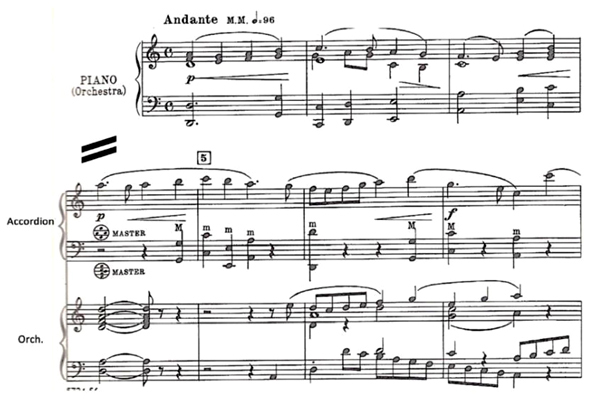
Example 1. Beginning of first movement of Concerto Brevis. |
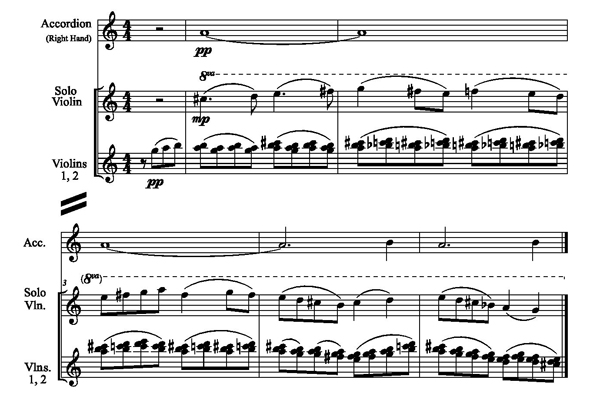
Example 2. Measures 29-34 of first movement including orchestral tone clusters in the first and second violins. Cowell sound sample. |
Second Movement: Allegro molto, quarter note = 132 / 4/4 time (common meter) / Tonality: D tonal center prominent; modality frequently changes due to much random chromaticism / Length: 82 measures / Other Observation: essentially a moto perpetuo whose two main alternating themes (labeled A and B below) are cast in unbroken sixteenth notes or eighth-note triplets; very lively, flowing nature / Form: rondo:
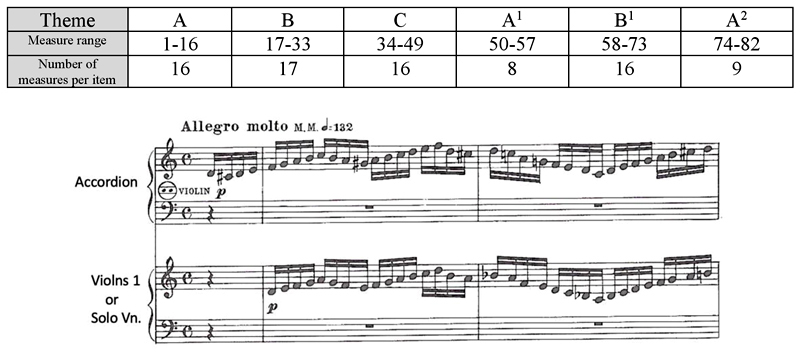
Example 3. Beginning of opening A theme of Concerto Brevis, 2nd movement |

Example 4. Beginning of B theme, Concerto Brevis, 2nd movement, measures 17-19. Frequent stretches of exact canonic imitation between orchestra and accordion parts, as seen here. |
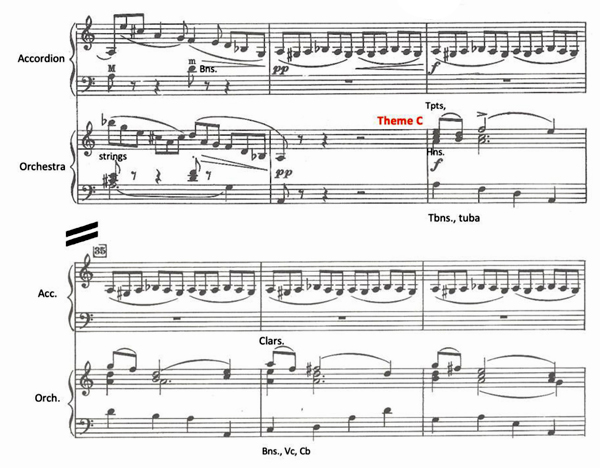
Example 5. Beginning of C theme (at measure 34), Concerto Brevis, 2nd movement, mm 32-37. Accordion echoes the theme entry at measure 42. |
The two returns of A theme are shortened by half while the single return of B theme is almost the same length as before. All three returns are otherwise varied somewhat, but not to a great degree. In addition, while A2 is not transposed, A1 is, by one whole step higher.
Third movement: Andante con moto, quarter note = 84 / 4/4 time (common meter) /Tonality: shifting major and minor effects, suggesting D minor or F major tonalities at first / Length: 77 measures / Other observations: Relaxed, rather sultry, Blues effect, due in part to occasional carefully placed minor triads felt as subdominant chords moving downward to would-be dominant chords, observable in the three-chord sets that frequently occur in the A sections / Form: rondo:
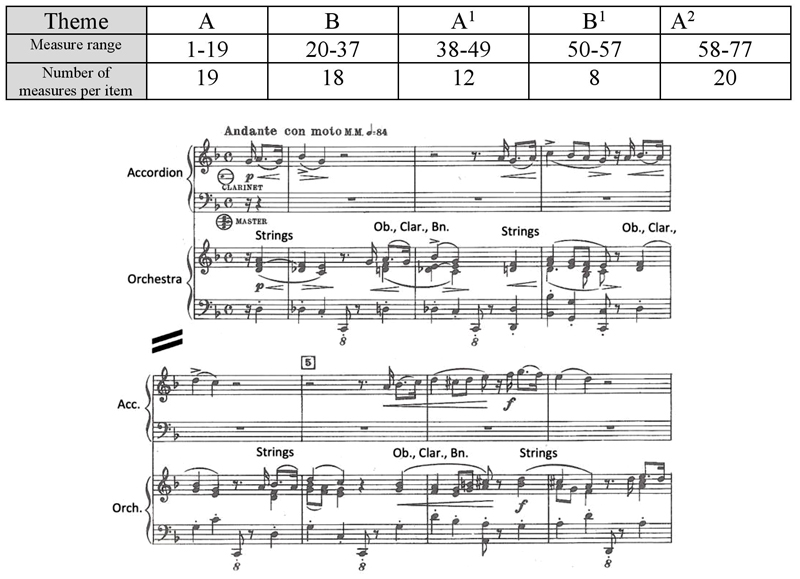
Example 6. First appearance of theme A, Concerto Brevis, 3rd movement, measures 1-7, shared antiphonally by accordion and orchestra. |
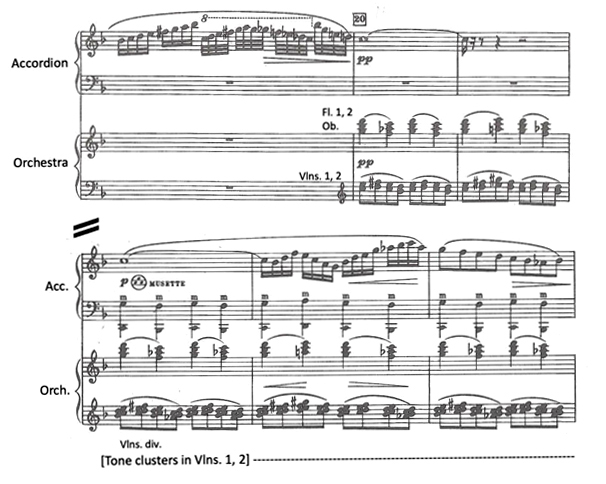
Example 7. First appearance of theme B, Concerto Brevis, 3rd movement. Measures introduced by the accordion in measure 20 accompanied by parallel, rocking, hypnotic 5/3 position major and minor triads and chord cluster figures in the orchestra. |
Fourth Movement: Vivace, dotted quarter note = 132 / 6/8 meter /Tonality: G- major/E-minor key signature; phrases shift between Ionian (major) and Aeolian (pure minor) modes throughout; final cadence is a G-major “tonic” triad / Length: 184 measures / Other Observations: in the style of an Irish Jig, typically featuring 4-bar phrases whose fourth measure is strongly accented; a favorite style of Cowell during this period; accordion solo for the first 29 measures; joyful, festive mood throughout / form: ternary, ABA theme structure:
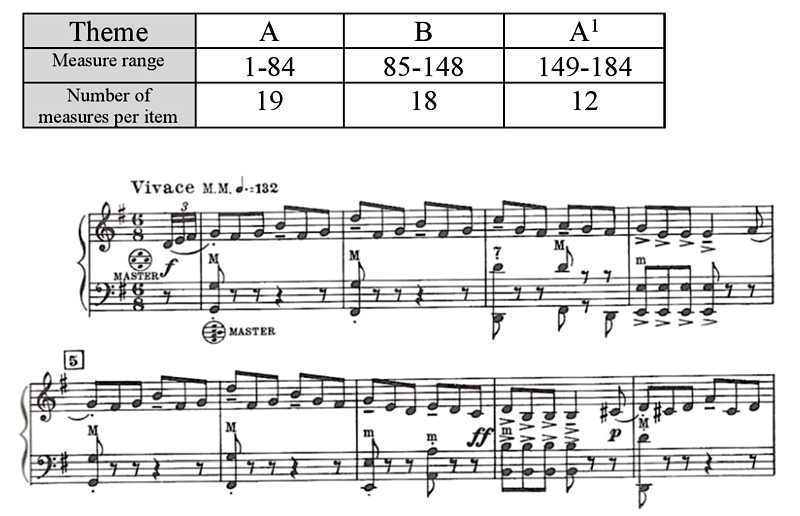
Example 8. A theme: Accordion solo beginning of Irish jig style fourth movement of Concerto Brevis. |
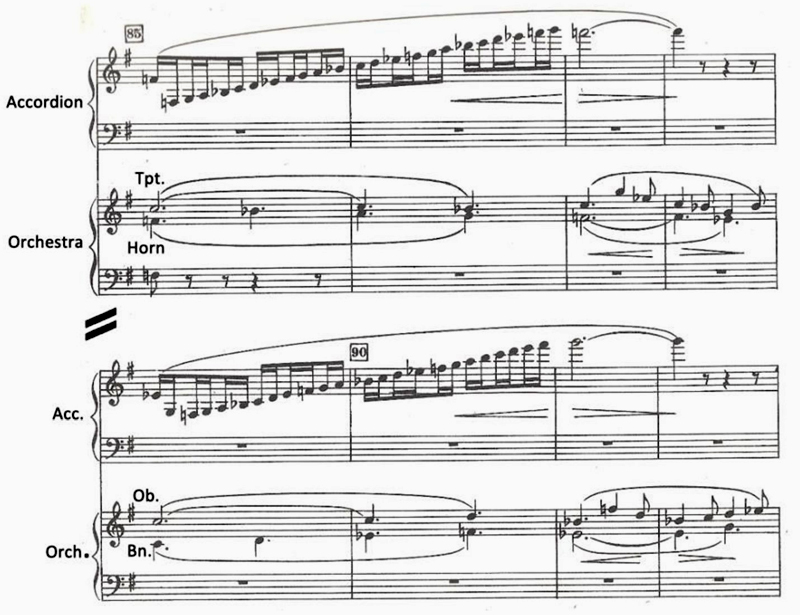
Example 9. Beginning of B theme in orchestra versus frequently ascending scales in the accordion part. Both parts initially using the F Mixolydian mode. Concerto Brevis, 4th movement, measures 85-92. |
Fifth Movement: Allegro, half note = 88 / [2/2] cut time, 6/8 / Tonality: variable and often uncertain due to much chromaticism; much melodic and harmonic use of unresolved fully diminished 7th chords. Final cadential chord of the movement is F minor / Length: 146 measures / Other Observations: the most varied, complex, frolicsome, and exciting movement of the work / Form: extensive rondo, plus cadenza and finale:
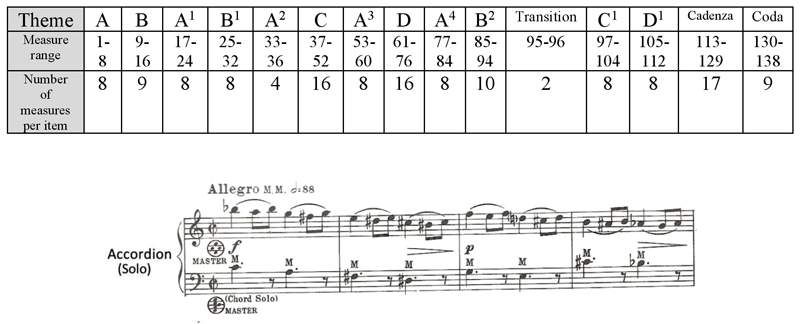
Example 10. Beginning of Theme A; accordion solo begins the movement, as it did in the fourth movement. Concerto Brevis, 5th movement, measures 1-4 |
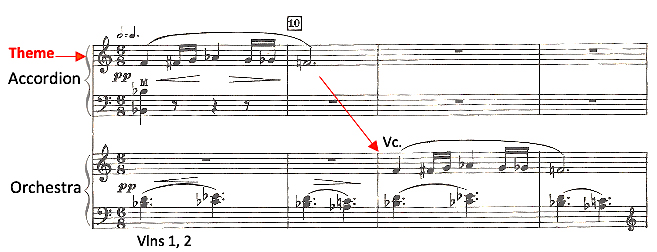
Example 11. Beginning of Theme B; antiphony between accordion and orchestra. Concerto Brevis, 5th movement, measures 9-12. |
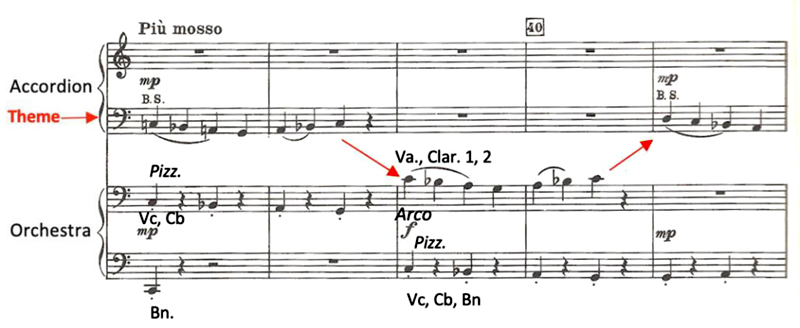
Example 12. Beginning of C theme, also shared antiphonally between accordion and orchestra. Concerto Brevis, 5th movement, measures 37-41. |
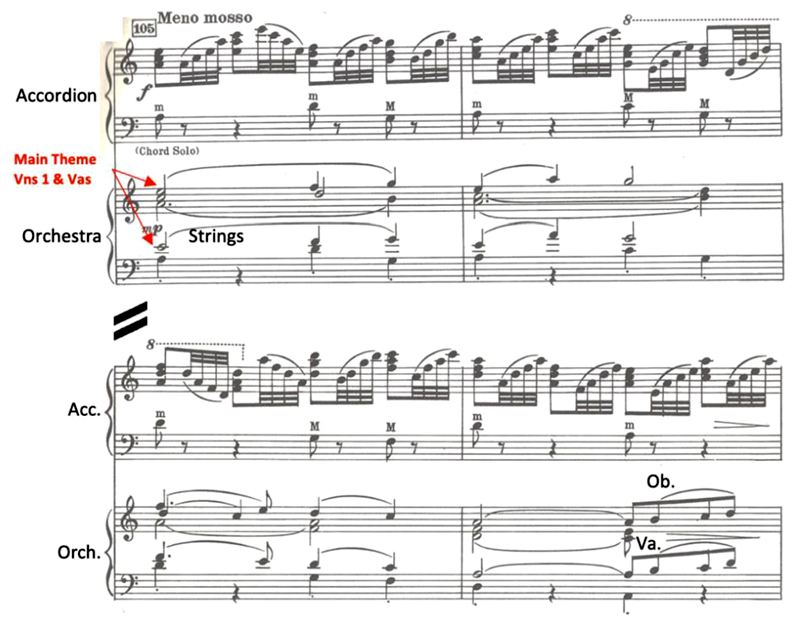
Example 13. Song-like Theme D1 in the strings driven by athletic accompanimental material by the accordion. (Same as initial appearance of the D theme at measure 61, but with fuller texture and harmony in the orchestra.) Concerto Brevis, 5th movement, measures 105-108. |

First page of Henry Cowell’s submitted score manuscript to Elsie Bennett of the Concerto Brevis. Lightly penciled in at the bottom of the page, probably by Elsie Bennett, is “[undecipherable] composer December 7, 1961” and to its right, “c. [meaning “copy”?] Pietro Deiro,” probably meaning to send a copy to Pietro Deiro Publications.” The published Pietro Deiro print accordion/piano score bears the copyright year as 1962 through MOMAC Publishing Company, 133 Seventh Street South, New York 14, New York. Elsie Bennett papers. |
Approximately five months after commissioning Cowell, Elsie Bennett succeeded in persuading her former professor at Columbia University, the equally long established and illustrious figure in American modern music Otto Luening (1900-96), to write for the accordion. This may have taken less effort on Bennett’s part than it had when she approached Diamond and Pisk for this purpose since it was Luening who had not only suggested to her in her student days that composers must be commissioned and paid to create works for the accordion if it was to ever have its own classical repertoire of note, but who also next attended an AAA Board meeting at her request to encourage its members to vote to do so. (Regarding this event, read more about it in the first article of this series, the 1997 issue of the AAA Festival Journal).

Otto Luening and his former student at Columbia University, Elsie Bennett. Left: At the American Music Center, New York, June 29, 1960, the year Rondo was commissioned. Right: Twenty-six years later at meeting of the American Society of Composers, Authors and Publishers (ASCAP) at the New York Hilton Hotel, October 29, 1986. Elsie Bennett photo album. |
Though the Milwaukee-born composer, flutist, conductor, and educator was often rather conservative in his compositional style and had written for acoustic instruments for most of his long and amazingly varied life, he possessed an experimental and pragmatic nature which led him to become one of the pre-eminent pioneers in electronic music after World War Il. By 1960, he had composed eleven electronic tape works, six of which were in collaboration with his noted Columbia University colleague Vladimir Ussachevsky, and was working on a sixth, seventh, and eighth (Gargoyles, for violin and tape, and with Ussachevsky, Concerted Piece, for orchestra and tape, and incidental electronic tape music to George Bernard Shaw's play Back to Methuselah) during that year. Nine more would follow through 1965.
It would have been a great triumph for the accordion at that time if Luening had decided to write something for it with tape. However, he opted instead to create a flashy, etude-like, moto perpetuo solo based largely on the chromatic scale and supported by simple diatonic harmonies. It seems obvious that he had the old vaudevillian stereotype of the accordion novelty in mind. He used rondo form to construct his piece and simply gave that generic title to it (rather than some descriptive or programmatic title as Frosini, Cere, or Magnante might have done in their well-known novelties).
Rondo was published by Pietro Deiro Music in 1962 and premiered that year by Carmen Carrozza in a recital at New York's Town Hall on Sunday afternoon, May 7. In addition to transcribed works of Bach, Chopin, and Liszt and the Luening selection, the program included four other AAA works that Carrozza had premiered earlier in New York: Paul Creston's Prelude and Dance, Wallingford Riegger's Cooper Square, Carlos Surinach's Pavana and Rondo, and Robert Russell Bennett's Four Nocturnes. (My discussions of these pieces may be read in my updated and expanded versions of the second, third, and fourth articles in this series, the first versions of which appeared respectively in the 1998, 1999, and 2000 issues of the AAA Festival Journal).
Two very positive reviews of both Carrozza's performance and the original works were written by John Gruen, of the New York Herald Tribune, and Howard Klein, of the New York Times. Regarding the premiered work of the day, Gruen described it as a "joyful and expertly turned-out study in the use of chromatic scales, that was never burdened by redundancy or coyness," while Klein was terser, simply commenting that it was "neatly handled" by Carrozza and "well turned out" by the composer. The piece is indeed "joyful," though it could just as easily be labeled "whimsical," "humorous," "frolicsome," "rambunctious," "misbehaving," or "clownish." It has a certain fresh and innocent quality about it that, if it were somehow transformed into a motion picture, might be designated as a G-rated farcical comedy. This may be largely due to Luening’s creating clear, periodic, conventional tonal melodic phrases that are, however, harmonized with random and often chromatic triads that are not among that key’s diatonic functional harmonies. The resulting effect is a bit scatterbrained, childish, random, and maybe even intoxicated-- in short, comical.
In the 1980s, William Schimmel gave a very exciting and suitably boisterous rendering of Rondo on his LP album Accordion Revisited (Finnander label, no. 90234-1). Both it and a recording by Carrozza may be heard on the CCC homepage of the AAA web page.
Rondo is divided into fourteen clearly delineated segments, as follows:
Further details and musical excerpts follow:
1) Introduction (measures 1-3);
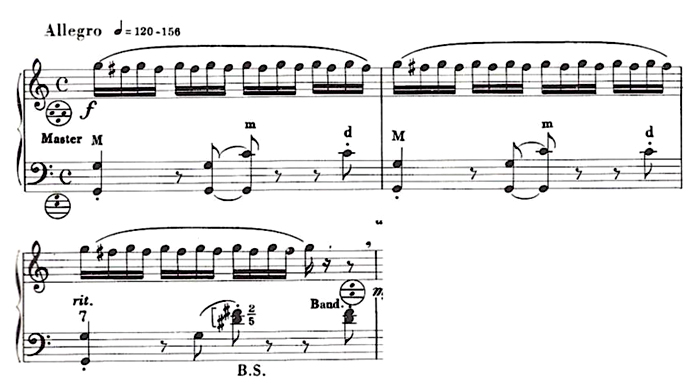
Example 14. Introduction. Rondo, measures 1-3 |
2) A (measures 4-19)
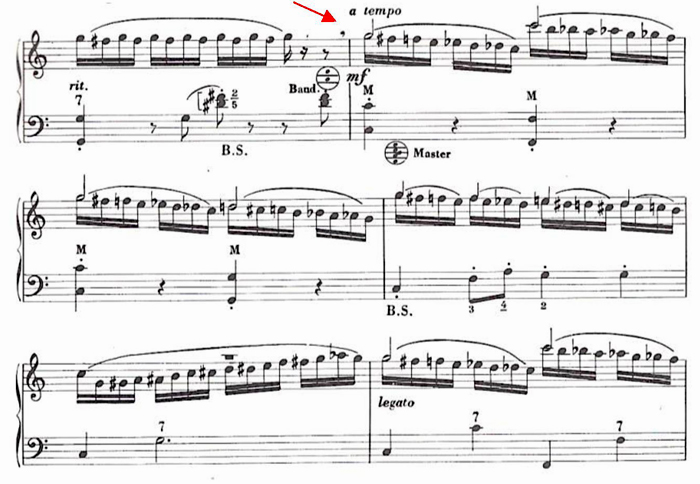
Example 15. Beginning of opening A theme (indicated by the red arrow, after last measure of introduction, measure 3). Rondo, measures 4-8 |
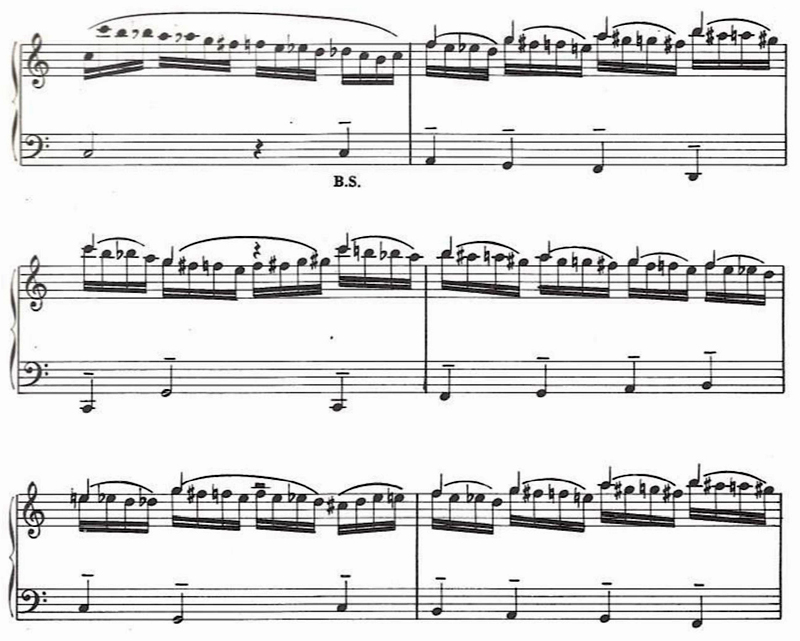
Example 16. Beginning of second segment of A theme. Main melody carried by quarter notes with upward stems in treble clef and mirrored in contrary motion in quarter notes in bass clef. Rondo, measures 11-16. |
3) A1: All still in the key of C major; first part adds a syncopated left-hand oom-pah accompaniment. See Example 17.
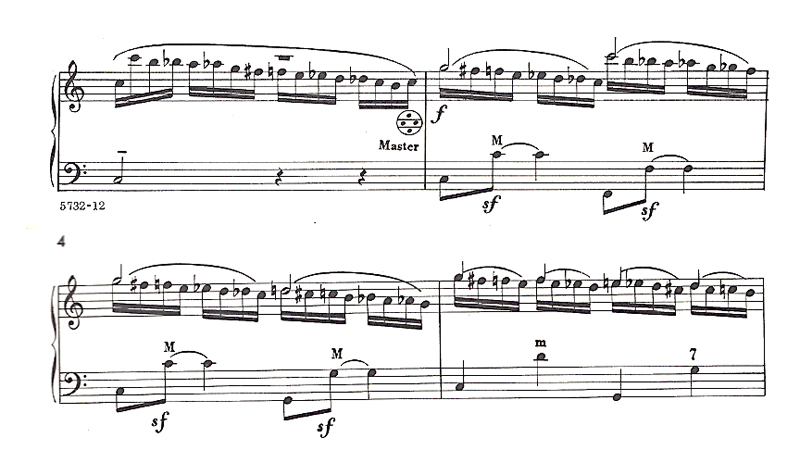
Example 17. Beginning of first return of A section (A1, immediately following end of A section except for a bridge of a single measure consisting of a descending chromatic scale, as shown). Rondo, measures 19-22. |
The second part of Al throws the earlier heard right-hand part of the original A theme’s second section (see Example 16) off by two beats, creating a humorously amateurish, fumbling effect, as if the now tardy right-hand part is trying to catch up with that of the undelayed left-hand which, unlike before, now carries that same line in the bass and begins it at the same “proper” point in the passage that the right-hand had first introduced it in the original A segment. This now creates a brief two-part imitative canon between the parts. Perhaps this adds to, rather than remedies, the zaniness of the passage, however, now causing the attentive listener to wonder if one part is late or the other too early. See Example 18 and compare it to Example 16.
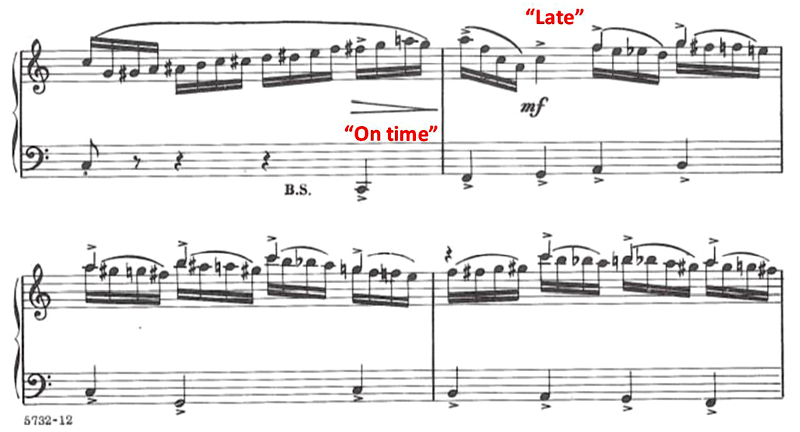
Example 18. Beginning of second half of A1 with offset right hand part coming in two beats “late” while same line in the bass is “on time” and where it originally was in the right-hand part of the original A theme (as seen in right-hand part of Example 16). Rondo, measures 27-30. |
4) B (contrasted with A by casting the chromatic scale sixteenth-note motif of the Introduction and A into the bass against short, sporadic, punctuated chords in the right-hand part). Frequent key changes resulting from a sequence of four four-bar phrases featuring non-functional major triads or rapid rising and falling sixteenth-note phrases that cadence on the following implied tonic triads of unrelated major keys prior to the return of the A section (item 5 below): G, A, E, and A-flat. The first of these phrases is displayed here (Example 19, measures 35-40). While beginning on an F-major triad and then passing through G and A-flat major triads, it strongly cadences on a G-major triad, thus prejudicing our ears to hear that as the tonic anchor of that phrase. Similar situations occur on the next three four-bar phrases, as just described.
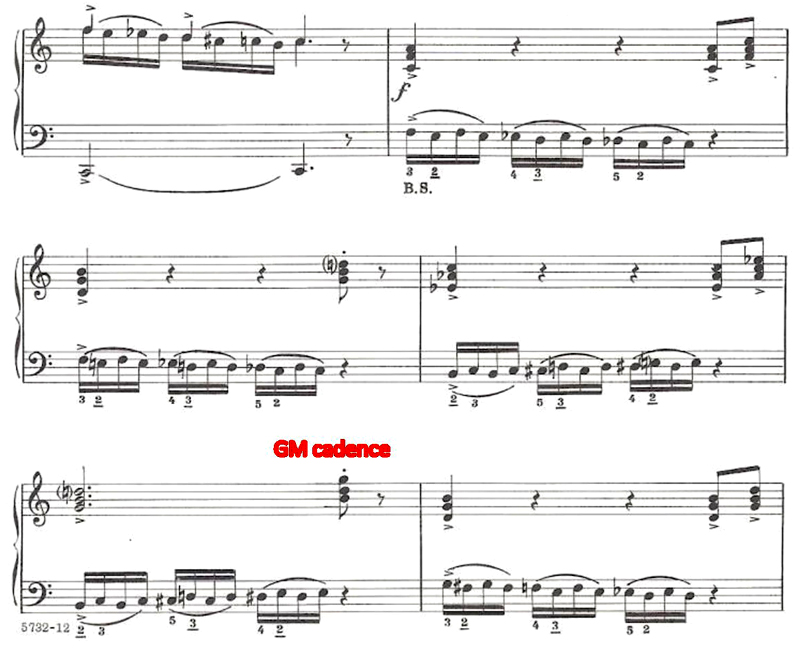
Example 19. First 4-bar phrase of four that constitute the B section of Rondo and link to the first return of the 3-bar Introduction and A2 (third occurrence of the A theme) |
5) and 6) exact, abrupt return of the three-bar Introduction and returning A (A2 section and return of the key of C-major);
7) C theme, key of F-major; typified by downward tumbling triad arpeggios immediately countered by rising chromatic scalar passages. Abruptly and ceremoniously “announced” at measure 71 by a sudden, comical C major/minor 7th dominant chord.
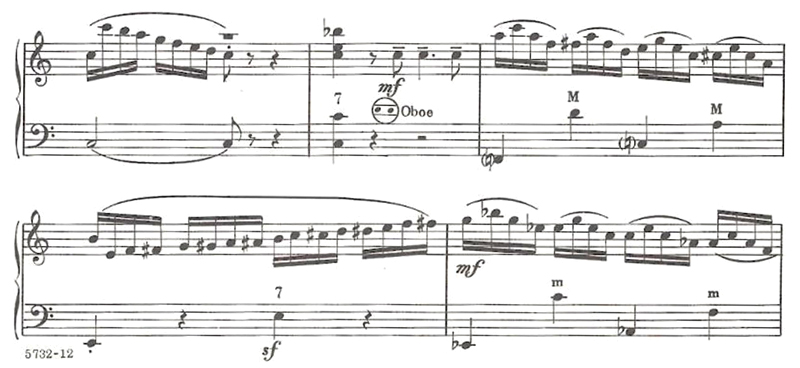
Example 20. C theme, beginning with boisterous introductory C major/minor 7th dominant chord, at measure 71. Rondo, measures 70-74 |
8) brief two-measure chordal transitional section, measures 88, 89.
9) Abstracted returning Introduction, measures 90-97, leading to
10) A3 (in C-major and truncated, using varied material from the second half of A), measures 97-105.
11) B1 (in F-major, also truncated and highly altered from its original B state), measures 106-121.
12) Unaltered return of initial 3-measure Introduction, measures 122-124. (See no. 1 and Example 14 above.)
13) A4 (in C major; much truncated from the original A), measures 125-140, leading directly to the Coda
14) Coda, marked "Grandioso,” based on second half of A theme. A comically grand-eloquent chordal ending. Measures 141-148.
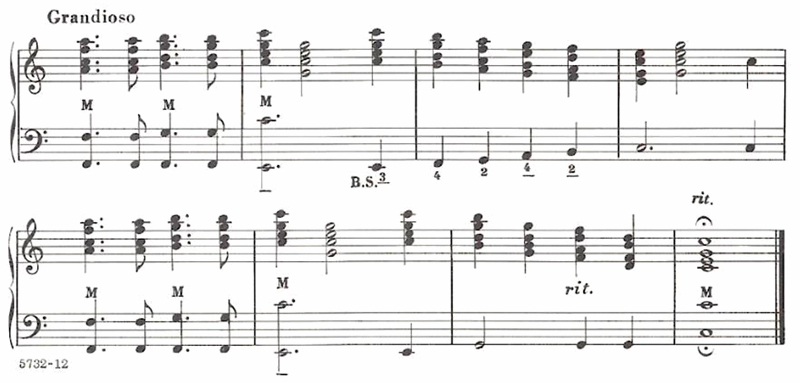
Example 21. Coda, based on the B theme. Rondo, measures 141-148. |
As can be seen, only two principal key areas dominate the piece: the tonic (C-major) and the sub- dominant (F-major). The lack of clear dominant key areas (which would be in G-major) deliberately creates ambiguity at times as to whether the piece is in C- major (though it is favorably weighted against F-major, since the piece begins and ends in C-major) or F-major (with C-major therefore possibly suggesting the dominant chord in the key). This is particularly noticeable in the Coda, which serves to throw the listener off somewhat concerning the tonality, as did the Al section throw him/her off rhythmically, further suggesting the earlier mentioned comical amateurish effect.
For all these reasons, Luening's clever and mischievous little gem for accordion was far from being in fashion with the prevailing, normally less frivolous atonal avant garde movements of its day (true also of the other two works explored in this article). But from the present, less biased distance of over six decades since its creation, it might be viewed as a far more unique contribution to contemporary music than it was then, possibly being an almost surrealistic experiment in rhythm and latter-day tonality as well as a kind of parody or burlesque of a once popular form of entertainment music.
In strong contrast to Luening’s clownish Rondo, Paul Pisk's Salute to Juan offers a more serious demeanor, taking the form and severe intensity of the tango. It joins two previous AAA commissioned works possessing Hispanic qualities as well, Riegger's Cooper Square (also essentially a tango) and Surinach's flamenco-like Pavana and Rondo (both discussed in earlier articles in this series, as mentioned above). The curious title for this work was explained by Pisk in a letter to Elsie Bennett as literally meaning “Greetings to San Juan, Puerto Rico,” because of its Spanish musical traits. (Perhaps, then, what would have been a full Spanish translation of the title--Saludos a Juan-- might have been more suave and fetching.) Though none of Pisk’s correspondence with Bennett explains his choice of title, it is probably safe to assume that he had visited that intriguing city, perhaps many times, and had a special fondness for it.
 Paul Amadeus Pisk (1893-1990) was born in Vienna where at one point in his extensive musical education he studied composition from 1917 to 1919 with Arnold Schönberg, the founder of atonal and serial technique and one of the most influential composers of the twentieth century. Due to exposure to many other directions music was taking afterwards, however, he became quite eclectic in his compositional style, as Salute to Juan certainly affirms. After teaching in many significant institutions in Europe in both the musicological and compositional fields, Pisk migrated to America in 1936 (as did so many Europeans in the arts during the early days of the Third Reich). Subsequently, he taught at the University of the Redlands (in California), the University of Texas, Austin (where he was situated when he was commissioned by the AAA in October 1960), and Washington University (in St. Louis). *
Paul Amadeus Pisk (1893-1990) was born in Vienna where at one point in his extensive musical education he studied composition from 1917 to 1919 with Arnold Schönberg, the founder of atonal and serial technique and one of the most influential composers of the twentieth century. Due to exposure to many other directions music was taking afterwards, however, he became quite eclectic in his compositional style, as Salute to Juan certainly affirms. After teaching in many significant institutions in Europe in both the musicological and compositional fields, Pisk migrated to America in 1936 (as did so many Europeans in the arts during the early days of the Third Reich). Subsequently, he taught at the University of the Redlands (in California), the University of Texas, Austin (where he was situated when he was commissioned by the AAA in October 1960), and Washington University (in St. Louis). *
An article in the June 1961 issue of Accordion and Guitar World announced that the accordion solo had been completed and would be published by the Alfred Music Company, as did happen shortly thereafter. A photograph accompanied the article showing Pisk, Bill Palmer, of the celebrated Palmer and Bill Hughes accordion duet team (both at the University of Houston where they headed one of the few truly burgeoning accordion departments in the nation at that time), and a Palmer student, Lynlee Barry Hatch, who was reported in the caption to be "running through Salute to Juan." As would make sense, Bennett, obviously living too far away from Pisk to confer with him in person on writing for the accordion and this project, as she had done so often with the many other commissioned composers in or much closer to her New York home, asked Pisk to work instead with his Texas accordionist neighbors and close associates of hers, at UH (though the two campuses were 160 miles apart in that vast state). He did eventually contact Palmer and drove to Houston for their conference. Soon afterwards, Palmer reported to Elsie that he only had to recommend a few technical adjustments in Pisk’s draft and declared the piece to be very well suited to the accordion and a fine work besides.

Bill Palmer, Paul Pisk, and Palmer accordion protégé at the University of Houston, Lynlee Barry (later Alley), posing with the score of Salute to Juan, ca. 1962. Barry likely matriculated into the University accordion program in or around 1954. She distinguished herself and her alma mater in 1957 by winning the US National Championship in the Accordion Teachers Guild national competition and representing the United States in the international Coupe Mondiale. Elsie Bennett/Paul Pisk correspondence, Elsie Bennett CCC correspondence files. Photo from article in June 1961issue of Accordion and Guitar World. |
The official premiere of the piece took place two years later in yet another Carrozza Town Hall recital, on April 28, 1963. Three other recent AAA commissions were premiered on that program as well, Tcherepnin’s Partita, Siegmeister's Improvisation, Ballade, and Dance, and Kleinsinger's Prelude and Sarabande. Also performed that day were three earlier, previously premiered commissioned pieces, Surinach's Pavana and Rondo, Bennett's Four Nocturnes, and Cowell's Iridescent Rondo. A brief review of the recital was given by Robert Jacobson in the June issue of Musical America which praised Carrozza's playing and two of the premiered selections, Agitato (not a commissioned work), by eminent accordionist/composer Eugene Ettore, and Tcherepnin's Partita. Regrettably, no special mention was made of Pisk's contribution and no New York newspaper critics were apparently in attendance.
A very brief description of Salute to Juan is related by the composer through Bennett in the above-mentioned Accordion and Guitar World article:
| The first and third sections have Tango rhythm, the middle part is agitated and fast like the Andalusian Jota. This portion is also used for the brilliant ending. |
A bold introduction, in the heavy "Accordion" shift, leads directly into the tango constituting the first of two principal themes, which is dominated by the brighter "Violin" and "Musette" registers (as indicated in the score). The middle "Jota" section, using at times the darker though edgy "Organ" register switch, does offer some relief from the intensity of the tango portions of the piece, and moves along at a slightly faster and more flowing clip. But for the most part, this is a work of unrelieved, aggressive energy that imparts a far more serious mood than do the stylistically related Cooper Square and Pavana and Rondo referred to above.
Salute to Juan falls into five distinct sections to be played one to the other without pause though clearly delineated from each other in the score by double barlines, tempo/expression indications, and metrical changes. Though the harmony is highly and colorfully chromatic, as is the nature of tangos, it is nonetheless traditional in all respects and does not reflect any of the “isms” or “alities,” such as bitonality, pantonality, pandiatonicism, or even atonality sometimes encountered in modern “neoclassical” adaptations of traditional dance forms.
A diagram of the score and musical excerpts with commentary follow.
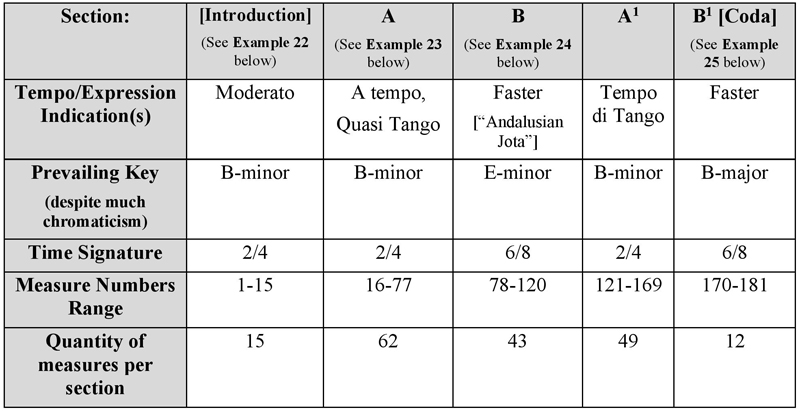
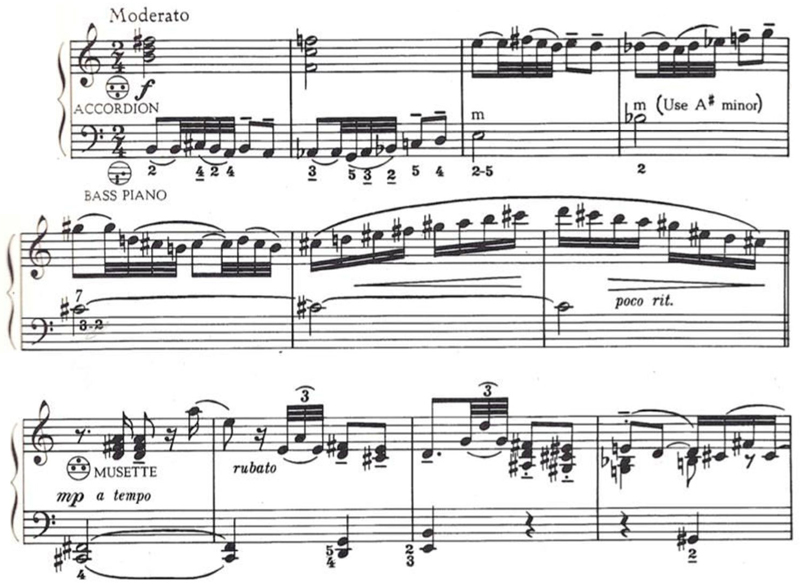
Example 22. The strong, bravado beginning of the first section (which I am arbitrarily labeling “Introduction”) of Salute to Juan. It is in the style of the tango as is also the second section (Example 23 below). In his terse description of the piece, quoted above, Pisk apparently views it and the well delineated second section, which he formerly labels as a tango for the first time in the score (“Quasi Tango”), to form a two-segment single section of the work since he speaks above of only two sections of the entire piece as being in that dance style (“the first and third sections have Tango rhythm”). |
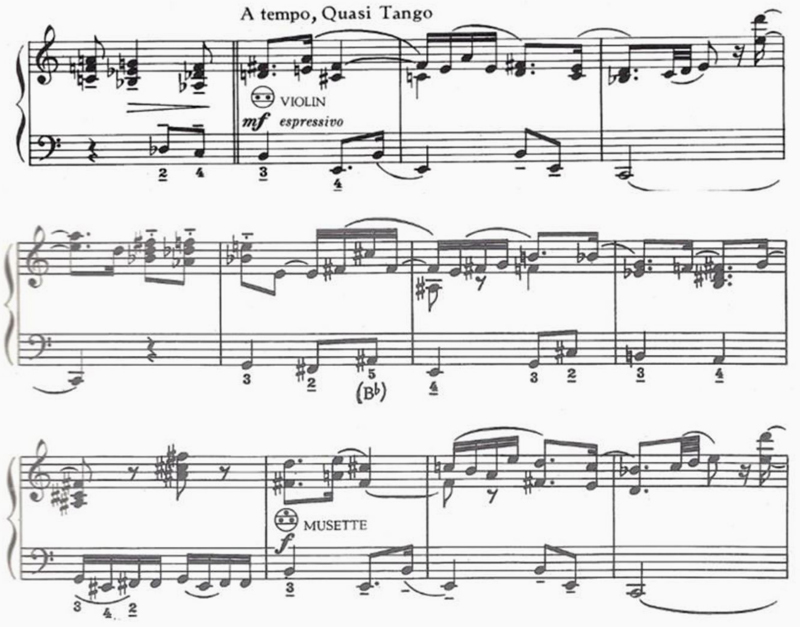
Example 23. Last measure of “Introduction” and beginning of the “Quasi Tango” section (labeled “A” in above table). Key of B minor. Measures 15-26. Note that the second phrase of the Tango (beginning at measure 24) has inverted the right-hand harmonic intervals as they first appeared in the first phrase (beginning at measure 16), thus changing the melodic line while repeating the same rhythmic and harmonic pattens. This will also happen at the outset of section A1 (beginning at measure 121), but in reverse order. |
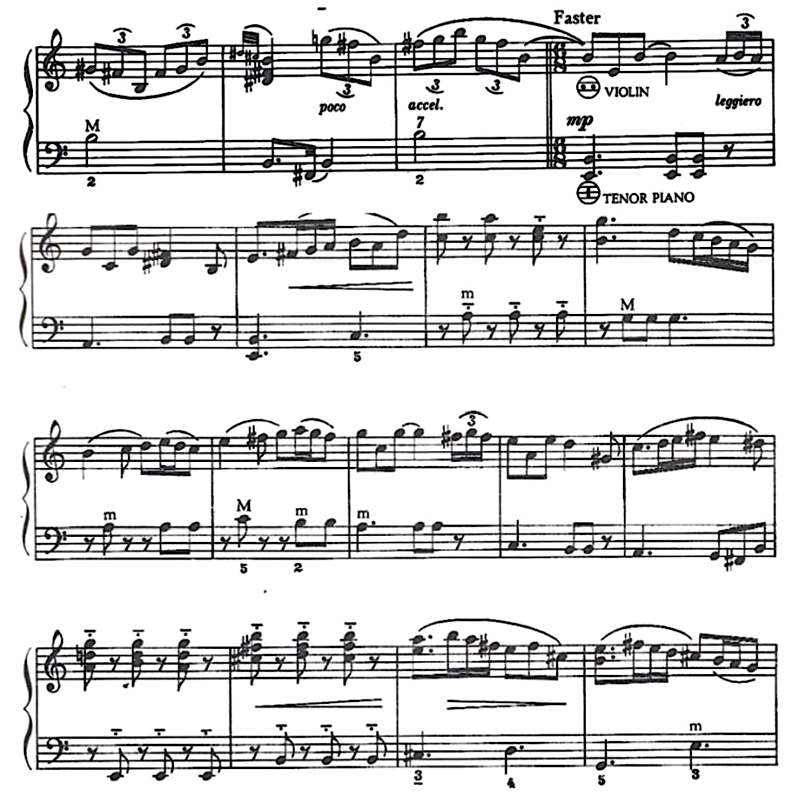
Example 24. Measures 75-91. Last three measures of A section (“Quasi Tango”) and beginning of B section (measure 78), referred to by the composer in his description of the piece as being in the style of an “Andalusian Jota.” The jota is a traditional courtly Spanish dance that probably originated in Aragon. It is usually in 3/4 or 6/8 meter with dance steps similar to those of the waltz. Key of E minor. 6/8 meter. |
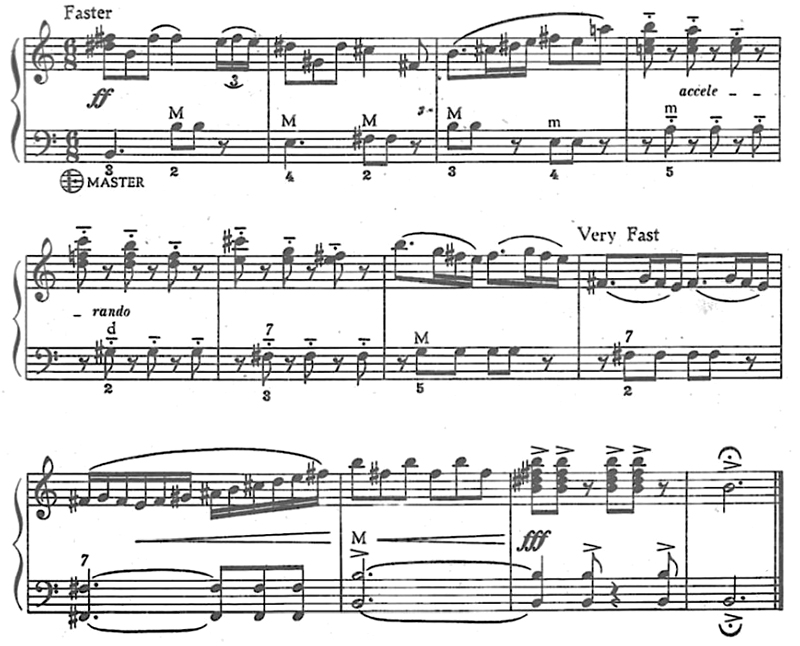
Example 25. The brief ending section (B1) of Salute to Juan, serving as a coda. Measures 170-181. The original B theme, now greatly shortened, has been transposed from the key of E minor to a cheerful B major to produce, as the composer claims in his description, a “brilliant ending.” |
Given this piece’s popular tango genre and considerably conventional harmonic language, it may be concluded that Pisk, possibly like Luening, primarily and stereotypically considered the accordion to be more of a folk than serious concert instrument. In any event, because of its strong and familiar Latin rhythms and sophisticated harmony, one could conclude that Salute to Juan, as well as the other two compositions discussed here, would not have been in vogue in the avant garde and highly experimental, progressive contemporary music circles of the 1960s or even today. All the above aside, though, Salute to Juan is a fine and well-crafted, as well as entertaining, piece that is certainly a step above conventional popular music and deserves many performances on any type of stage.
Elsie Bennett commissioned Pisk once more, in late 1961, this time for a much more ambitious project: a work for two accordions and orchestra, to be counseled once again by Bill Palmer in addition to his University of Huston accordion faculty colleague Bill Hughes, both of whom would also hopefully premier the work. This would be the seventeenth AAA commission. See the updated and expanded version in this series of the original article that appeared in the 2005 edition of the AAA Festival Journal for a thorough account plus sound samples of this wonderful work, entitled Adagio and Concertante.
The AAA Composers’ Commissioning Committee welcomes donations from all those who love the classical accordion and wish to see its modern original concert repertoire continue to grow. The American Accordionists’ Association is a 501(c)(3) corporation. All contributions are tax deductible to the extent of the law. They can easily be made by visiting the AAA Store at https://www.ameraccord.com/cart.aspx which allows you to both make your donation and receive your tax deductible receipt on the spot.
For additional information, please contact Dr. McMahan at grillmyr@gmail.com
2026 AAA 88th Anniversary Festival Daily ReportsAugust 13-16, 2026 Latest NewsMario Tacca, Mary Mancini AAA fundraiser. 2026 AAA Elsie M. Bennett Composition Competition 2025 AAA Elsie M. Bennett Composition Competition Results AAA History ArticlesHistorical Articles about the AAA by AAA Historian Joan Grauman Morse Music CommissionsHistorical and analytical articles by Robert Young McMahan. Recent articles:
AAA NewslettersLatest newsletters are now online. |